The Best Livestock Feed Storage Containers
If you are struggling to find a way to store feed for your animals that will keep it free of pests and bugs and moisture-free, can be tricky but good news, it doesn’t have to be.
I have my list of storage options we have used on our homestead, along with the pros and cons of each. Refer to this list of livestock feed storage containers and find the best option. Homesteading tips can be helpful, especially when looking for a quick and easy solution.
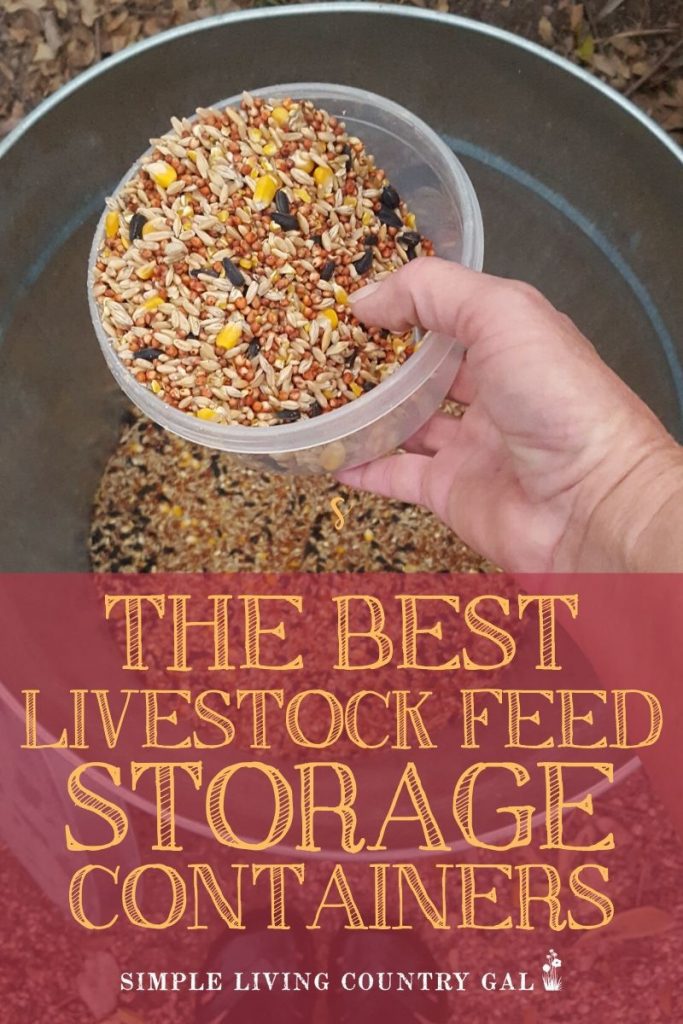
One of the joys of having a homestead is the mix of animals you can raise together. Many hobby farms and family homesteads tend to resemble more of a zoo, which, if you ask me, is one of the perks of being a homesteader.
It’s not uncommon to see goats and cows grazing in a pasture with llamas and chickens alongside them. And sure, those animals can all chow down on the same pasture grass and browse, but when it comes to individual feed, this is a whole other story.
Each livestock animal has their own nutritional needs, meaning there most likely is a feed/grain mixture made specifically for them. One that will give the best nutritional value that meets that animal’s specific requirements.
This is usually a grain mix of some sort, but there is more than that. Each livestock has minerals, supplements, and even treats specific to them. This means the more animals you raise, the more different types of feed you will need to keep on hand and store in your barn or other livestock building.
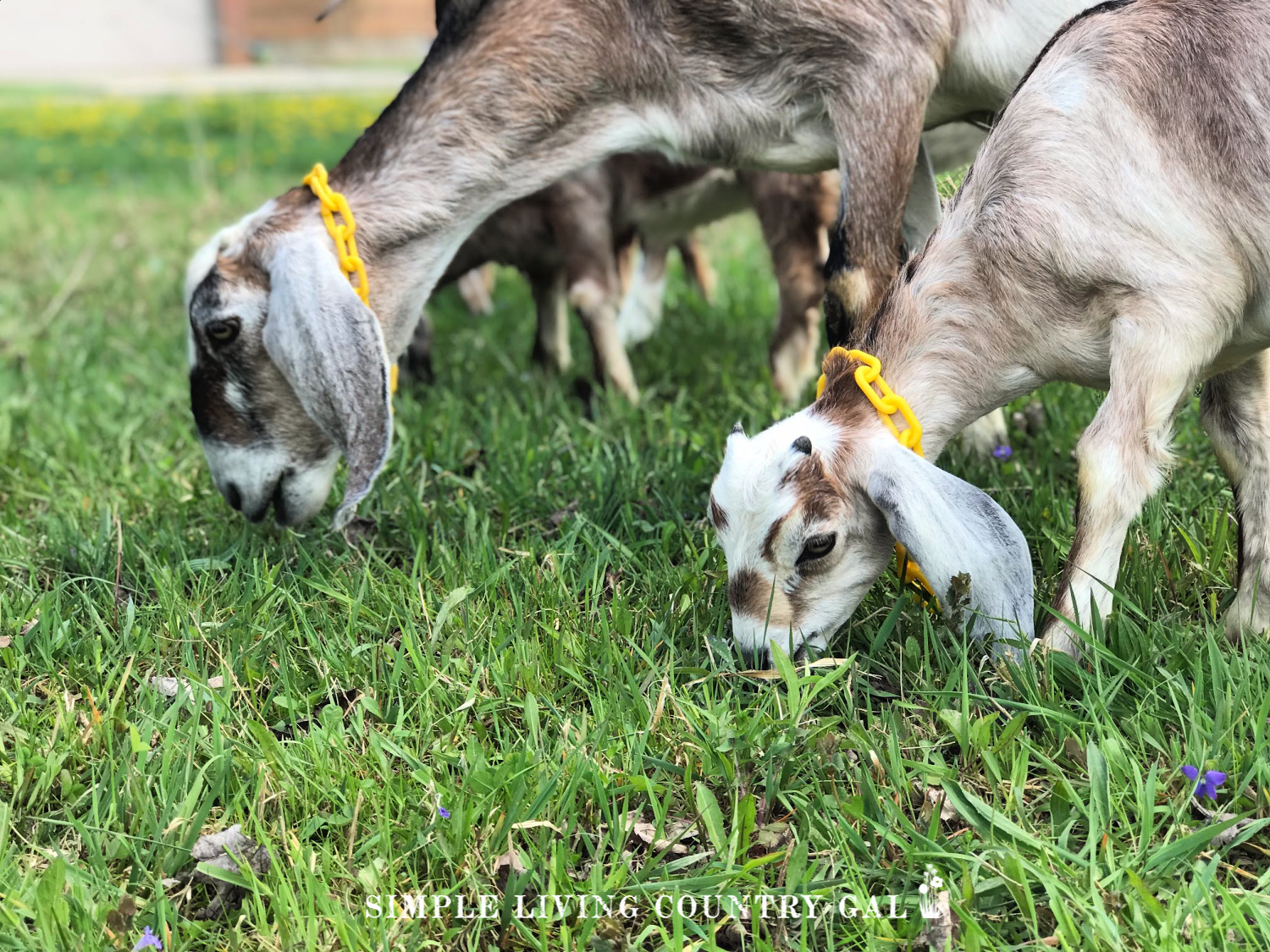
This was something I found out rather quickly that needed to be done correctly from the beginning. Finding durable options that will safely store all the different feeds, supplements, and minerals will ensure the food is kept fresh and will help to keep the rodents and bugs out.
SLCG Pro Tip: Never ever give moldy or spoiled food to your animals. This will not only harm them and their digestive systems but may even kill them.
A good rule of thumb to have is this: If you won’t eat it, don’t make your livestock eat it. If it’s going to make you sick, odds are it will make your livestock sick as well.
How do you know if livestock feed is spoiled?
There are a few signs that feed may be spoiled or moldy.
#1. Smell – The first and most obvious sign is the smell. Anything that smells sour, moldy, or mildew is a clue that something is off. Get into the habit of smelling feed before you give it to your animals.
#2. Sight – Always inspect the feed before you use it. Look for signs of mold, moisture, or mildew inside the bag or container.
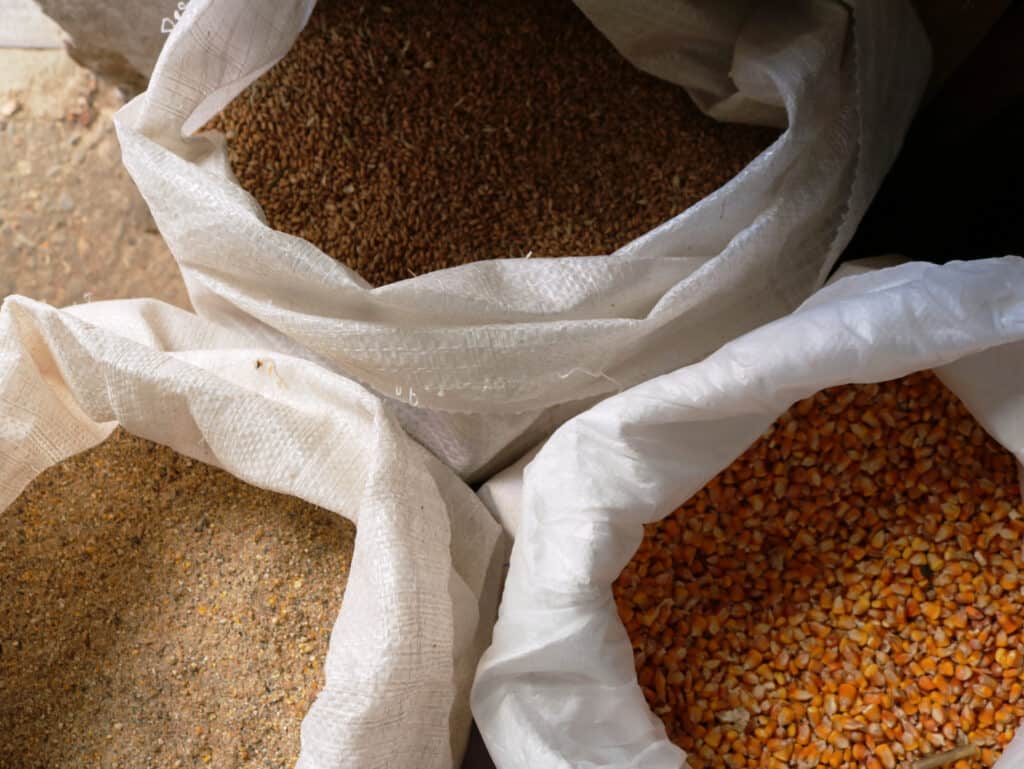
#3. Feel – Finally, touch your feed. Use your hands to feel the feed for dampness, a slimy feel, or fuzz. All of these are hints there is an issue with the quality of your feed.
Be sure to grab the FREE Livestock Feed Container Checklist below!
How do you keep rodents away from livestock feed?
Do you know that old saying, for every mouse you see, there are 100 or more hiding? Okay, maybe that is not a saying, but trust me, it’s (almost always) true. How do I know? I experienced this firsthand, and it took just one bag of chicken feed left on my barn floor to find out.
I like to stock up on purchases for our family and our animals. The fewer times I go into a store, the more money I save. For that reason, it was not uncommon to find 4-5 bags of feed stacked in our barn.
One day, as we worked our way down to the bottom of our chicken feed stack, we realized one of the bags had been chewed open and quite a bit was missing. I can only imagine how many mice we fed with that one bag. It took our two cats and weeks of trapping to get our barn free of those pesky rodents.
That day was a turning point for our barn’s setup. We set to work building a feed room off the back and set it up using sturdy, durable feed storage containers to keep pests, rodents, and moisture out of our livestock’s feed and minerals.
Below is a list of all the storage I have tried myself. Some will work better than others, and I tried to give my own rating system for each. This will help you better decide which will work best for you.
finding the best options:
When looking for storage, consider the following list before investing.
- Their ability to keep pests out.
- Does it have an airtight (or close to it) seal?
- How well they keep the food fresh.
- How easily it can moved around even when they are full.
We do not have issues with ants where we live, so I do not know how well each option works to deter them. If you live in an ant area, I would love to know what containers you like and why.
Just leave a comment below so I can add your information to this list.
The Best Livestock Feed Storage Containers
As I mentioned before, this is a short list. The options I have tried out on our home homestead. I wanted to be sure I only reviewed the options I used so I can give you a more honest viewpoint of each.
Feed Option #1. Metal feed storage containers
This was the first container option I used to store our livestock feed, and it worked great for a while. One large barrel can hold 3-4 bags of 50 lb chicken feed or 100 lbs of pig feed.
You can use these barrels to store full bags of feed or you can empty the bags inside and feed directly from there using a large scoop.
Steel barrel drums work great because they do hold quite a bit. The one downfall is that you seriously cannot move them once you fill them.
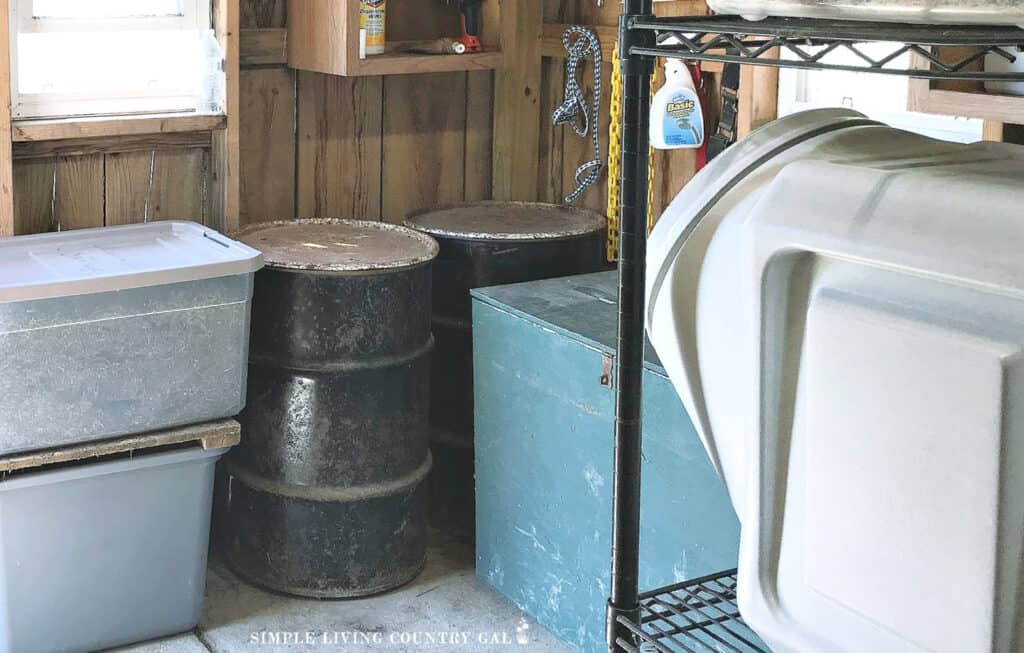
Since the lids do not lock down securely on most metal drums, placing a brick on the top usually keeps the mice out.
SLCG PRO TIP: Never underestimate a mouse. They can fit into the smallest of holes, bringing their entire family along. This means you will want to be thorough when securing your lids so. Hopefully, you will never have to deal with these pests.
Metal Feed storage containers Review
Pro: Metal barrels are incredibly durable. Once you buy one, you can expect it to last. You can usually find these for sale on Craiglist, making it a more affordable option.
Cons: These barrels take up quite a bit of room and are not easy to move, even when empty. Another con is it can be incredibly difficult to get that last 50lb bag of feed out of a large metal drum. This was something that was impossible for me, given my shortness.
Bottom Line: A great way to store bags of feed in a very secure way. Barrels are also perfect for holding large amounts of feed.
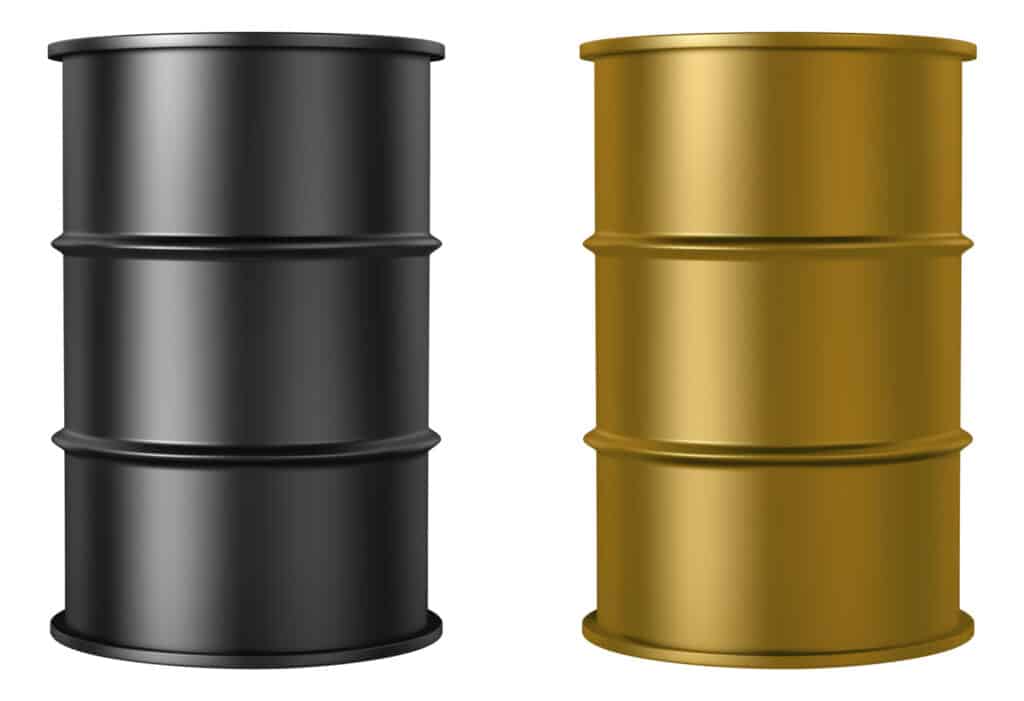
Feed Option #2. Plastic Totes
I love using plastic totes of all sizes to store our livestock feed and herbs. I still use smaller shoebox-sized totes, as they work great for the different ingredients we use to mix our own feed.
They are inexpensive and can be stacked up, taking up much less room in your storage area. This is especially helpful if you have a small feed room, as we do.
Since most plastic totes have handholds on either side, you can easily move them even when completely full of feed.
Sterilite Storage Box 13.5


If you are stacking totes, you will want to label them clearly on the side so you can easily find the feed or supplements you need.
Since we had multiple totes for each breed of animal, I like to keep things stacked together. My feed room has a section for ducks, one for chickens, pigs, goats, and even our dog and cat. This helps to keep your feed room more efficient.
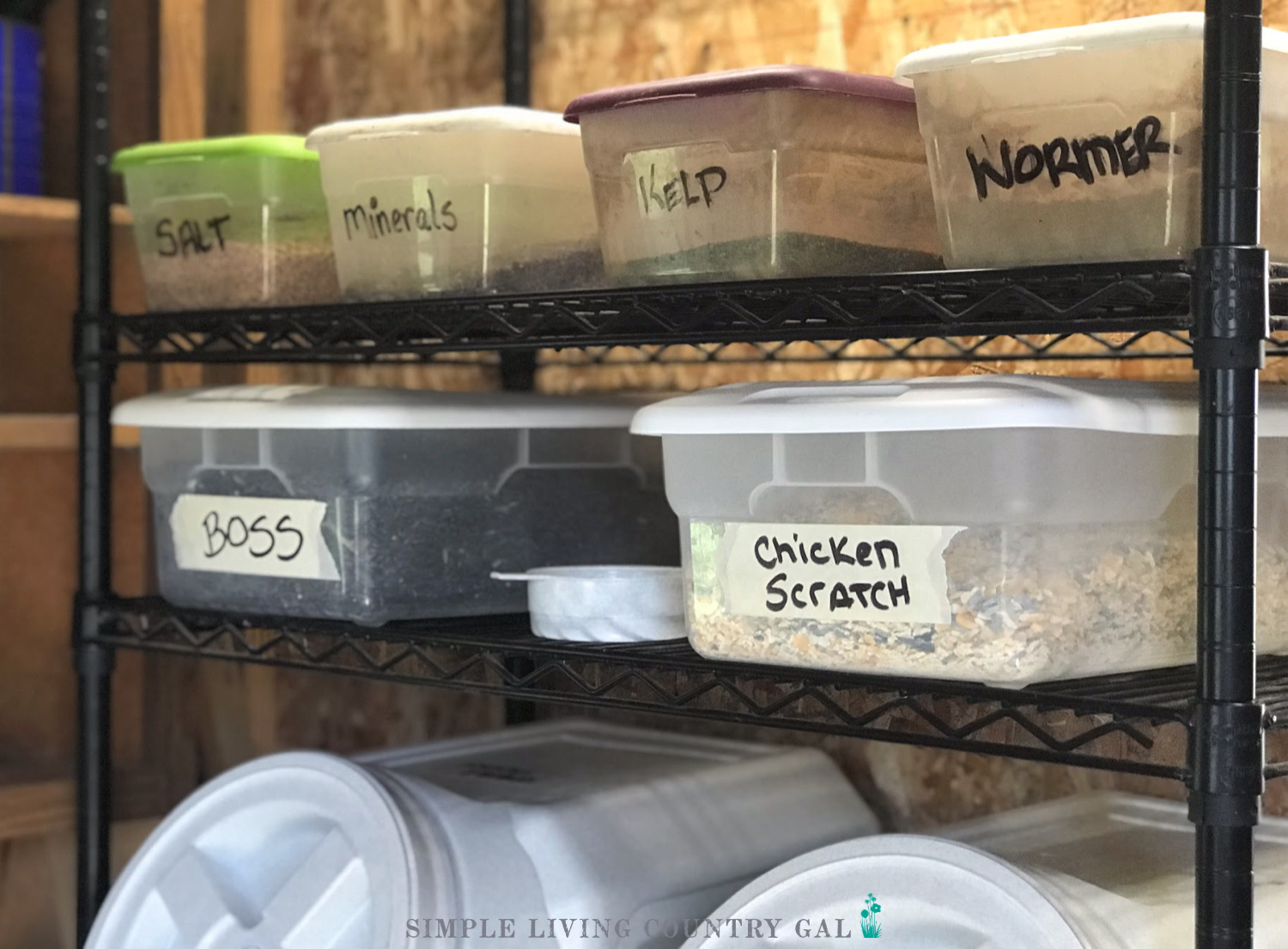
Plastic Totes Review
Pro: Easy to move even when full, and if you purchase like brand and sizes, they can stack up nicely. If the lids fit securely, they work well to keep mice out and the feed dry.
Cons: Normal-sized totes cannot hold a full bag of feed. This means you will need a second tote to hold the rest of the feed, or you will want to find another way to store partial bags until you need them. They also do not last forever, especially if you live in an area where the winters get cold.
Bottom Line: Totes are inexpensive and work great in a small livestock shelter since they can stack easily, taking up much less room.
Feed Option #3. Tack Box
Tack boxes work great to hold a wide range of feed and supplements.
What is a tack box?
A tack box is a plastic or wooden box with a hinged lid. They can range from simple open boxes to ones with shelves and other containers inside for storage.
Tack boxes are great for holding miscellaneous supplies, traveling with livestock, or as food storage containers. These boxes are quite common in barns and can hold up to a few hundred pounds of feed at once.
We have one in our feed room that we use to store partial bags and miscellaneous items. Since we live in a damp area, we have our tack box on wood board to hold it up off the ground. This way, if we have any flooding in our feed room, the box and feed inside will remain dry.
You can purchase tack boxes or build your own, as my dad did for us.
Just remember, if you choose to make your own box, you will want sturdy handles that will allow you to move it around more easily. I love our rope handles since this means I can drag a full-tack box away from the wall to clean.
Frequent cleaning is a major requirement if you want a mouse-free barn.
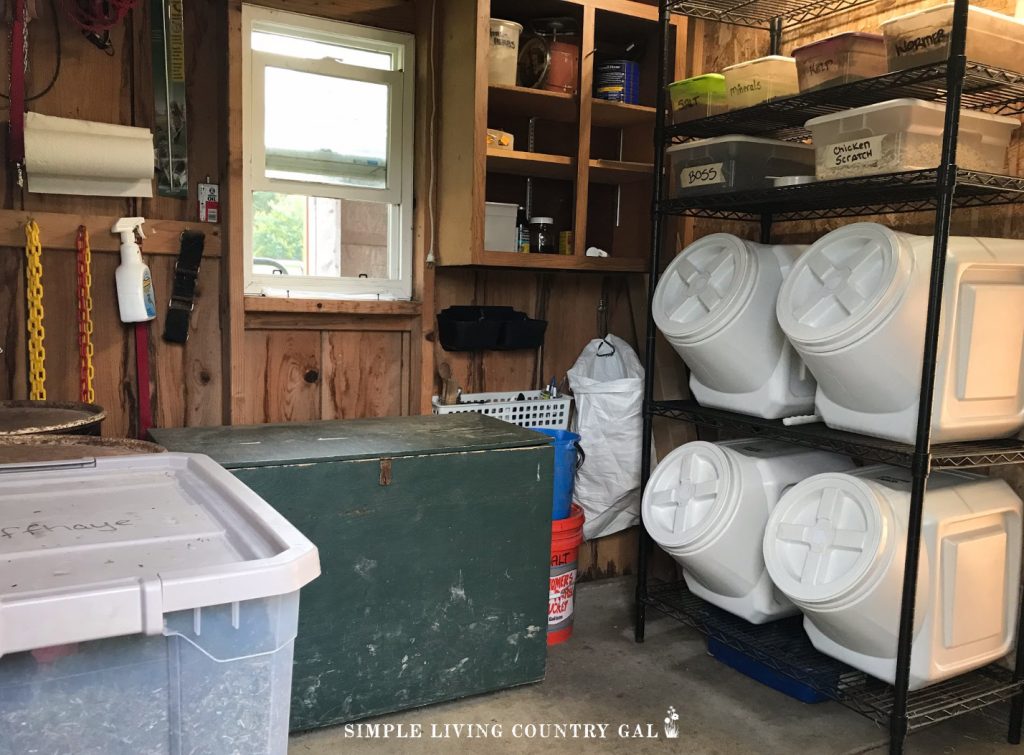
Tack Box Review
Pro: Tack boxes work great to hold multiple bags of food and supplies. It can also double as a bench making it so easy to mix feed on.
Con: It can be hard to keep the contents neat and organized inside. Spills tend to happen when you have different bags of feed opened for mixing. This puts another cleaning task on your homesteading chores list, one that is probably already longer than your arm.
Bottom Line: Tack boxes are a nice way to store food and give you a work table at the same time. This is great for smaller hobby farms where room is a bit short.
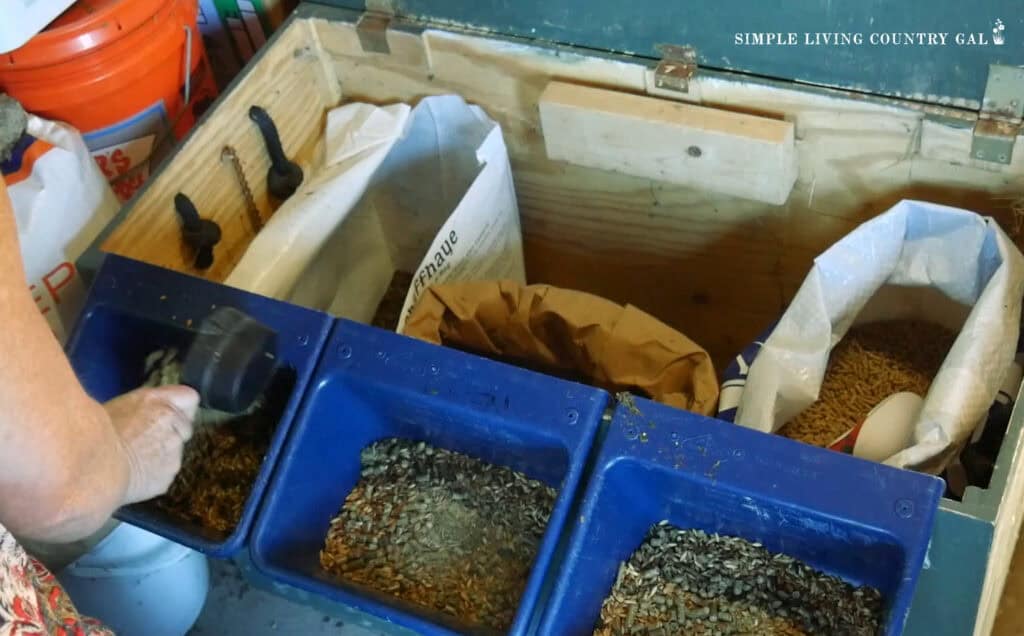
Feed Option #4. Plastic Feed Storage Containers
A few years ago, I decided to invest in livestock feed storage containers from Vittles Vault that are specifically made for storing feed.
These stacking containers resemble bins and have round lids that you can easily screw on and off, keeping mice completely out. Inside is a scoop, but it is a bit on the small side. Each container will hold 50 pounds of feed. This surprised me since the bins look relatively small.
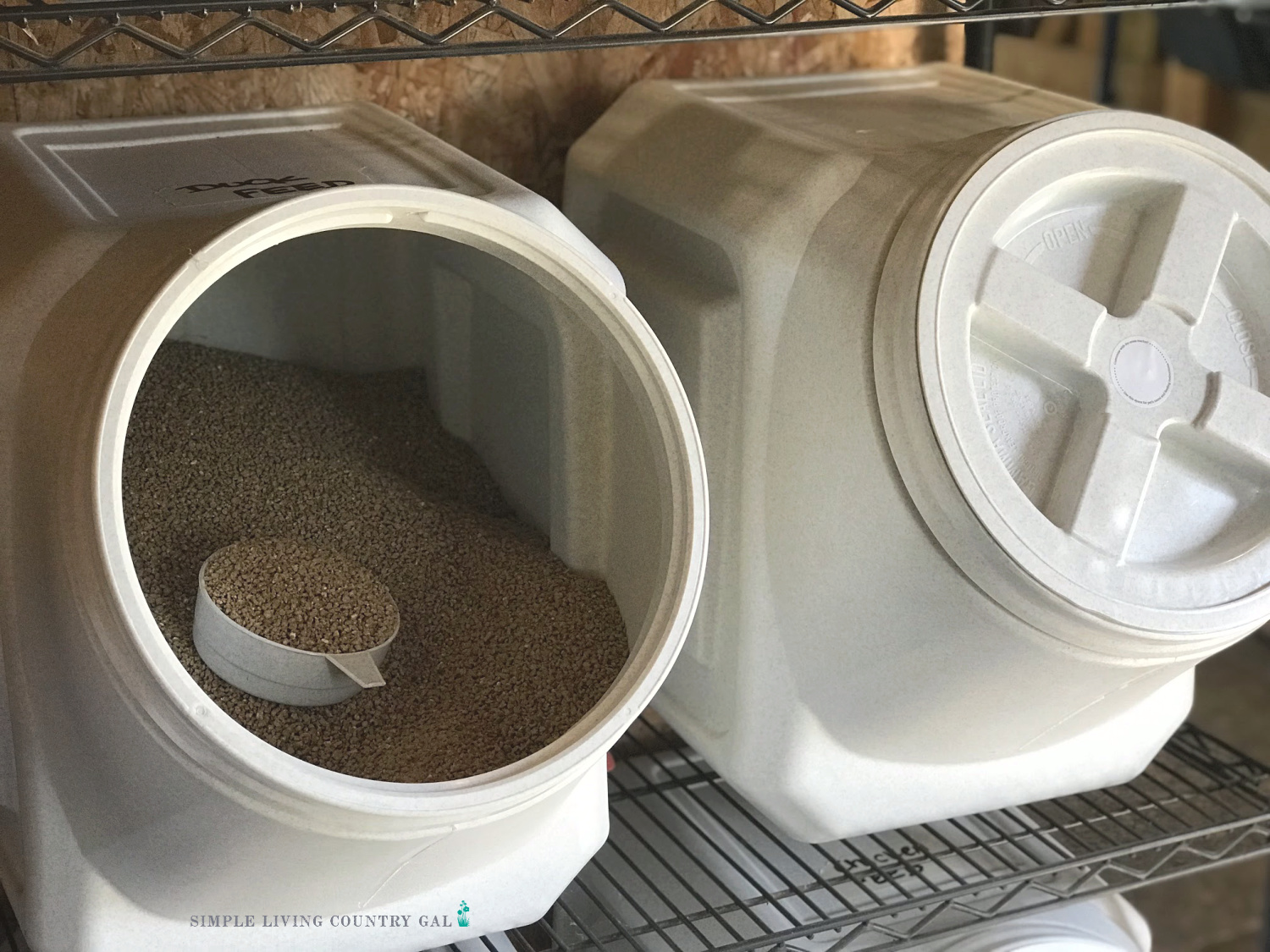
There are handholds on the sides of the plastic bins that make them easy to move even when full. They also have an indent on the top and bottom that allows you to stack them, keeping them in place so they do not topple even if bumped into.
Gamma 2 Vittles Vault are completely rodent-proof, from my own experience, because they are made of very thick plastic and have tight lids with a rubber ring seal allowing you to keep it securely in place.
Gamma2 Vittles Vault Stackable Dog Food Storage Container, Up to 60 Pounds Dry Pet Food Storage, Made in USA

We have used these containers for several years now, and they are my favorite way to store feed both in our barn and now in our home as well. I have never had a bug or pest invade the contents inside, making this an investment worth the money.
Plastic Feed Storage Containers Review
Pros: Can hold quite a bit of feed and are easy to move. They stack nicely and work great on wire shelving. Come with a small scoop for convenient mixing and portion control. They keep out rodents and pests and do great at keeping the feed dry.
Cons: They are somewhat expensive and, for that reason, may not be the best option for a newer homestead.
Bottom Line: These feed storage containers are my top pick if you can afford the investment. Their size is the perfect chicken feed bin holding a 50-pound bag nicely. They also come in different sizes, so you can mix and match them based on your needs.
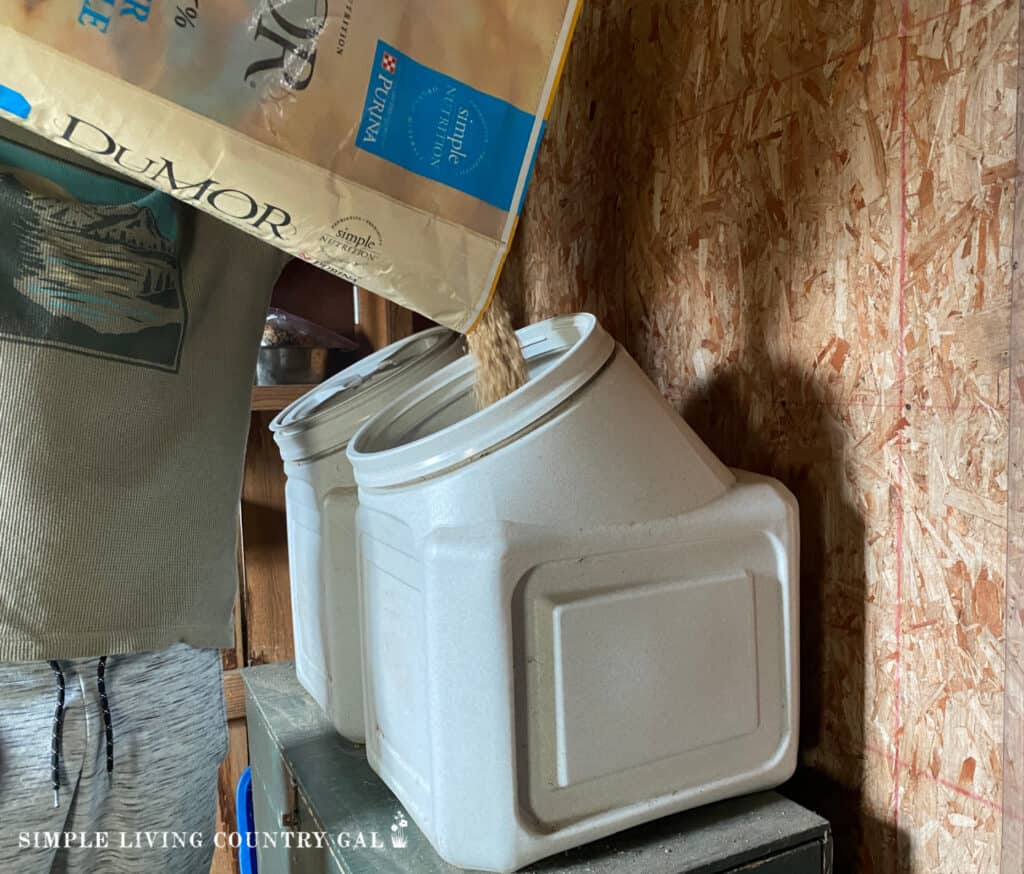
Feed Option #5. Trash Cans
If new livestock feed storage containers are not in the budget this year, yet you still need a feed storage option, then galvanized garbage/trash cans might be a solution worth considering.
This simple and affordable approach will help keep mice and rats out of your feed. We used this storage option for quite a while and found it to work surprisingly well in our barn and feed room.
Pros: Trash cans hold quite a bit and are somewhat easy to move, especially if they have side handles. It is also easy to reach all the feed, even at the bottom.
Cons: Most trash cans have lids that cannot close and lock, so you will want to anchor them down by setting a heavy brick on top or using rubber bungee chords to lock them into place.
Bottom Line: This a great option if you are starting out and want a secure way to store your feed that will keep large rodents from chewing through the container.
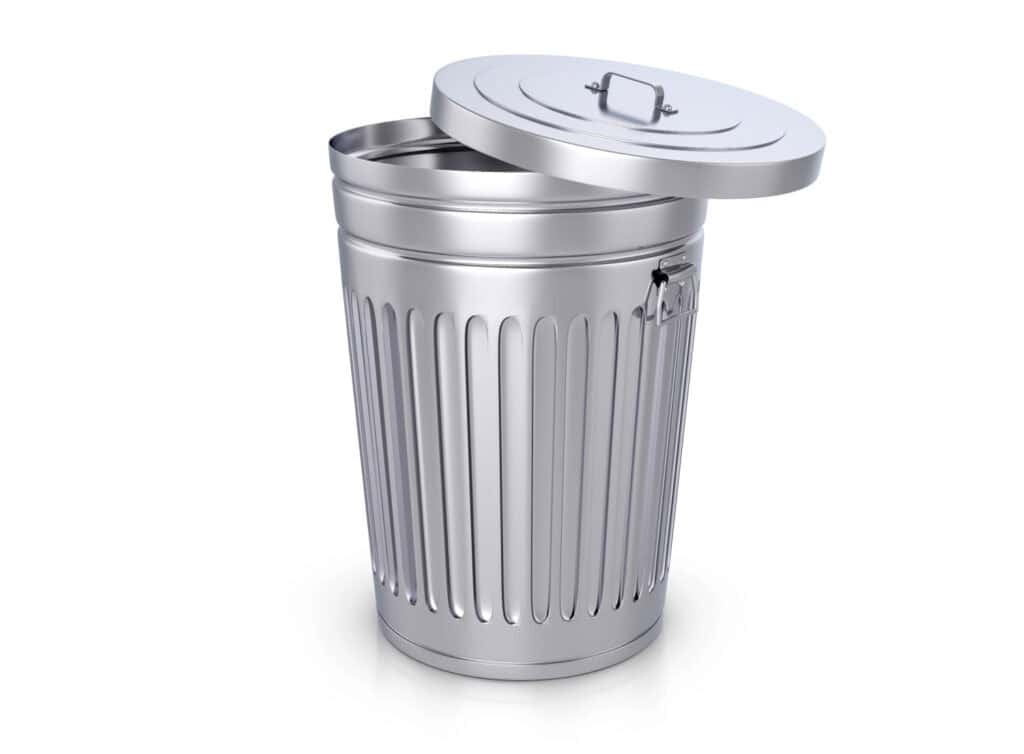
Feed Options #6. Stackable feed storage containers
If you are short on space, stackable feed storage containers will give you maximum storage using minimal space.
When stacking, remember that if the lid is on top, you will need to remove any containers in the stack to access them. Also, in order for the stack bins to be stable, look for containers that are meant specifically for stacking.
A few stackable options are:
- Gamma2 Vittles Vault Stackable – This is what we use and one option I highly recommend.
- Slant Open Storage Container – Smaller openings for smaller scoops.
- Stackable Bins with Hinged Lids – These do NOT look rodent-proof, but it is a more affordable option.
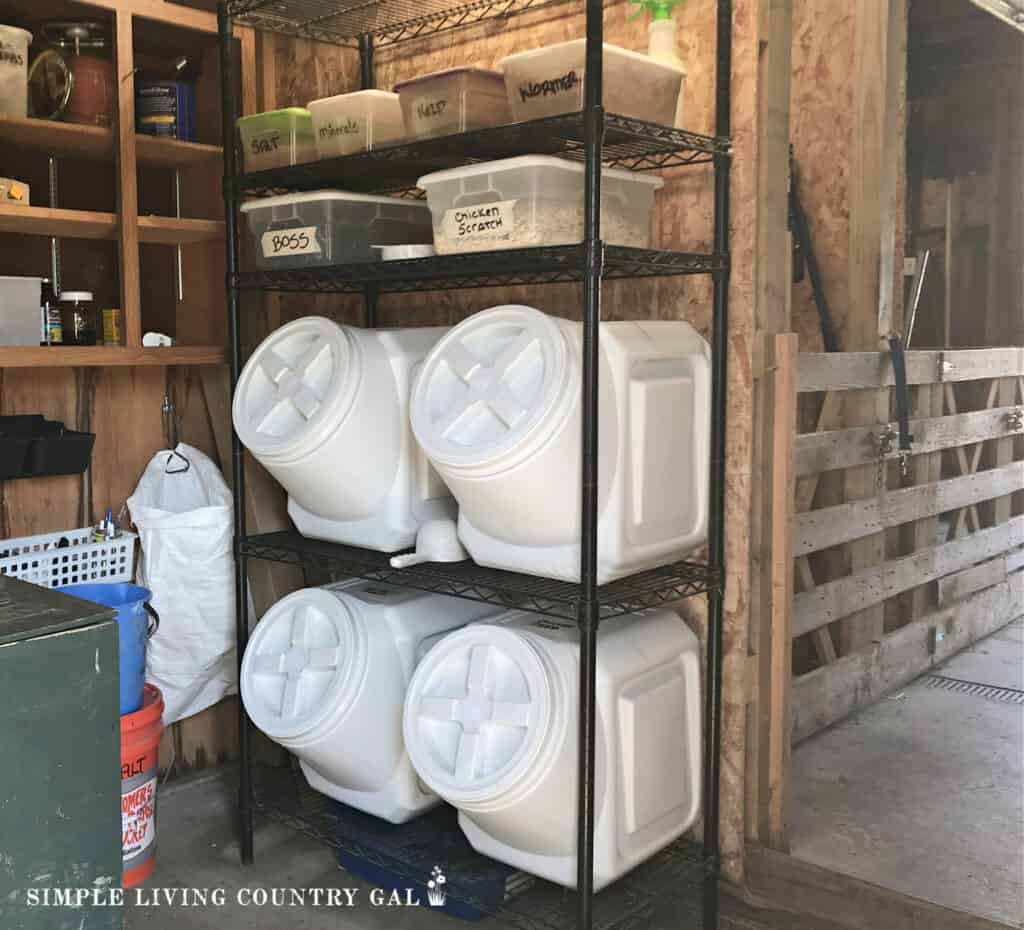
Bonus Livestock Feed Storage Supplies
No matter which option you choose, you will want a way to move things around without risking injury to your back. I like to use flatbed rollers for this. Set them under your can or barrel before you fill it. Not only will these cards keep your storage container off the ground you will be able to roll them around as needed.
Another tool to have is a good-quality feed scoop. We like to have one in each storage bin so we can easily scoop out what we need without making a mess.
A heavy-duty shelving unit is important so it can hold up to the weight of your feed containers. You can adjust the shelves to store your containers on them no matter their size.
A dry-erase board is good for keeping notes for feed rations and recipes.
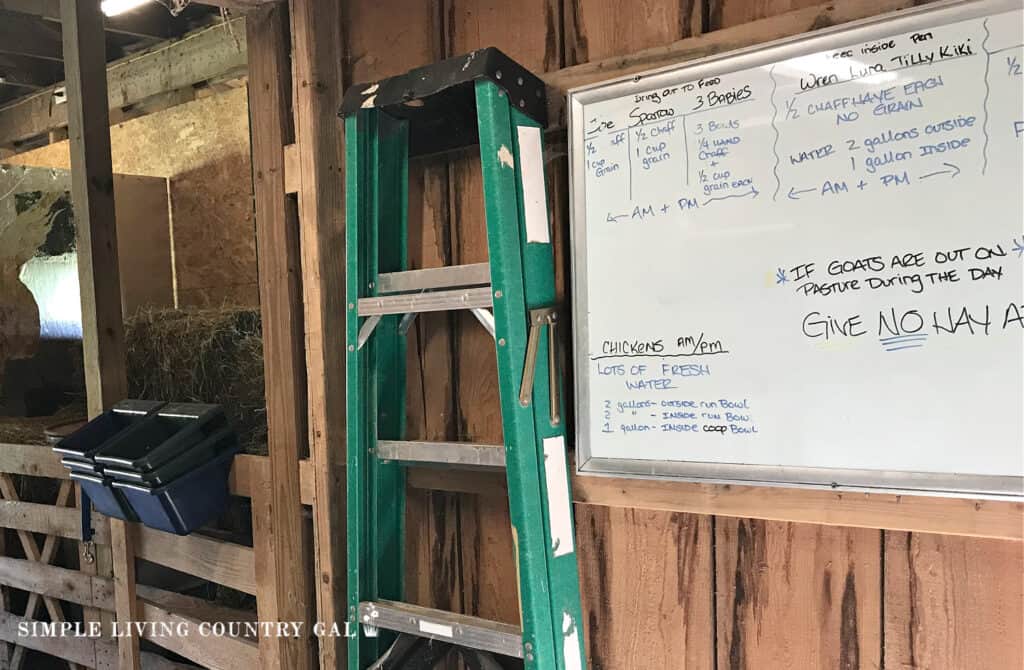
Having durable and secure storage in place will help to keep what you feed your animals fresh and free from rodents and mold. Not only will this help you to raise healthier animals, but it will save you money as well.
Feed for your animals can be inexpensive, so investing in ways to allow it to last while keeping its quality is a good way to invest your time and money.
The good news is that once you find a method that works for you, you can relax knowing you have streamlined this part of your homestead.
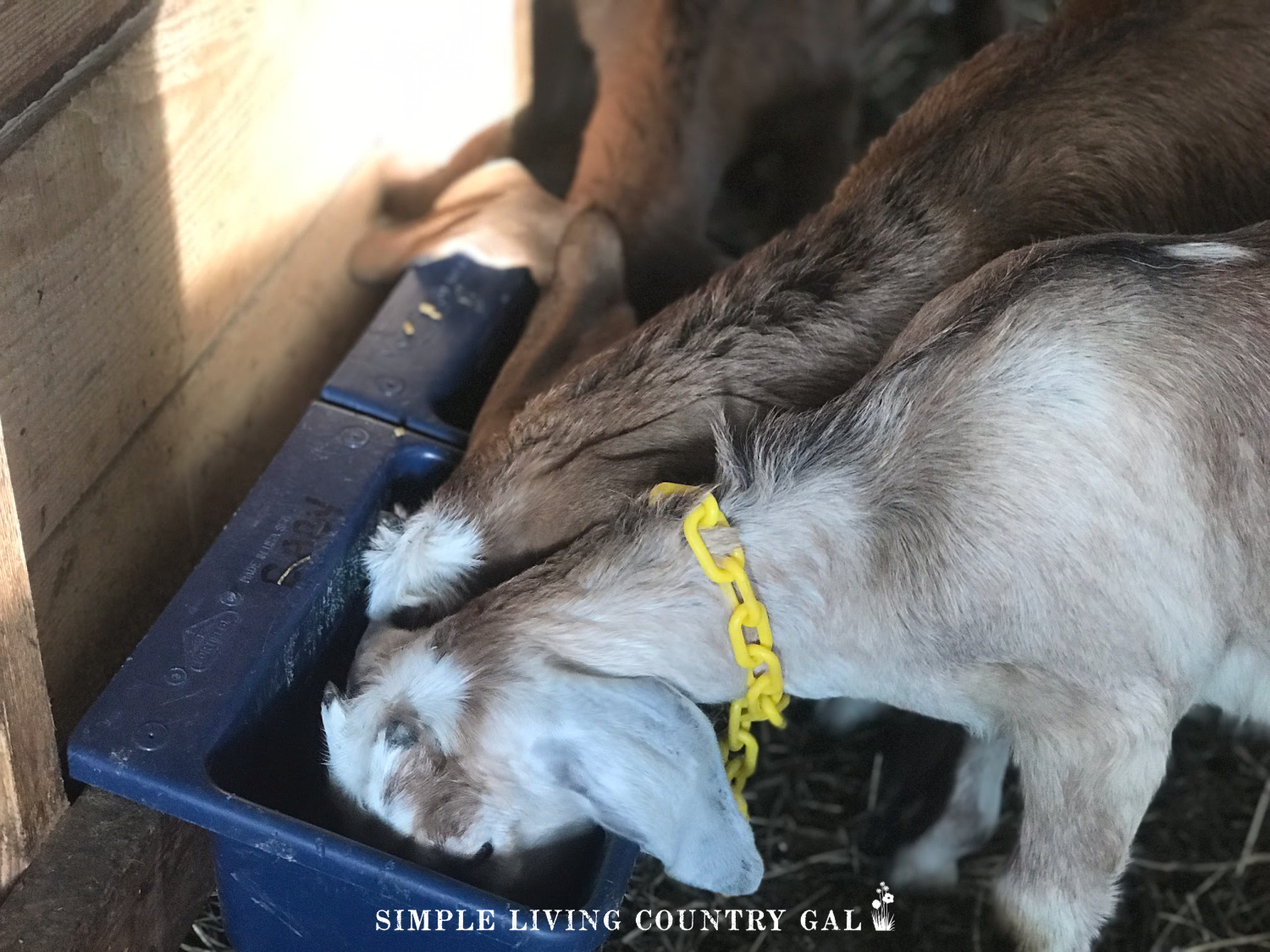
I hope this list helps you to find an option for your own feed storage that will work best for you so you can create a money-saving, not to mention nicely organized, feed room that you enjoy being in.
Even if you have just a few chickens, a single pet, or an entire homesteading zoo, as we do, having a secure way to store your animal’s food with livestock feed storage containers is not only good for the quality of the food but economical for you as well.








Have you ever used an old chest freezer for food storage?
Hi, Kelly,
No, I have not, I am kind of terrified of old freezers and the chance of kids getting locked in. Totally irrational but where my head tends to go.
Tracy Lynn
Yes. I even leave one outside for horse feed. Do need to add locking mechanism as horses and kids can open lids. Make sure water tight if outside
It’s great to learn that tack boxes can be great to store food and are easy to use to mix feed on. My wife and I are wanting to get some farm animals and we were wondering how we could feed them effectively. I’ll be sure to tell her that we should consider getting tack boxes for the animals.
How do you keep bugs out of feed? The mice and rats are not the problem, but find little bugs in the bottom of a 50lb bag of feed. I only have 2 small Nigerian Dwarf Goats and don’t go through the feed as quickly. It tends to get wasted. Any other suggestions for storage? I also live in FL so the heat and humidity is awful.
Hey, Sharon!
I have not had any issues with pests in the feed because these containers do seal up pretty tightly with the rubber ring you can use. If you do have bugs, then they were already in the feed before you put them into the containers.
Not very common with store-bought feed, but happens a little more if you purchased feed from a mill.
Another reason why I like the containers is as I m dumping in new feed, always use up the old before you adding any new, I can inspect the new feed as I am dumping it in for anything mold, pests, eggs, or other defects.
I hope this helps!
Tracy Lynn
Is there a way you can “share” with a neighbor to split the bag up so you go through it more quickly? You can also freeze the extra if you have a large freezer with enough space to do the job.
Tracy Lynn
Thank you for explaining a few different ways to store feed. My sister has been trying to find the best way to keep her feed fresh. I’ll be sure to share this with her so that she can get a good idea of what she can try.
Just rehomed a lovely Maremma guard dog for my 100 layers and hes doing awesome. I chose to bring two of his nubian goats with him to make him feel at home. Problem is they are 5 yrs old, registerable, never been breed and are wild. I have gotten them to eat minerals out of my hand and a few choice vegies but not able to touch or pen up. Got any ideas? They have a strawed stall thaw that is 9X12 with a door, hay, grain bins etc. Can’t close the door they are too fast.
When you have skittish goats that are older you will need to really work with them but please know that not all goats are “trainable”. I got a couple of Boer goats a few years back and they were the most skittish goats I ever had. I worked for weeks and weeks trying to get them used to me but they never got over it. I had to eventually rehome them to a bigger farm where they could just run the pasture day and night. I am not saying that is what will happen with you, just keep trying. If they are eating out of your hand that is a huge step. Continue doing this and hopefully, they will become a bit tamer as time goes on.
Good luck! Tracy Lynn
i have organic pig feed that is 1 yr old.it was kept in a tin building setting on 2 inch pool surronding walk way. i put it in a 55 gln drum but some of the bags had holes in them and a few were damp. been stored in it for atleast 8 months now. piglets wont eat it now. could it be no good now.
There is a very good possibility that it is no longer good to eat. Pigs usually eat just about anything so if they are not eating it, that may be a sign that it is spoiled. I would not run the risk as feeding spoiled feed can make livestock very sick.
Do you have a feed mill close by? If so I would take a sample to them and see what they think.
Good luck,
Tracy Lynn
Hello! For easy access by a chicken coop, would something like a deck box work to keep feed containers in? They are suppose to be waterproof but I worry about condensation.
On very hot and humid days you will want to keep an eye on things. At the very least, only keep a small supply so you do not have to worry about mold.